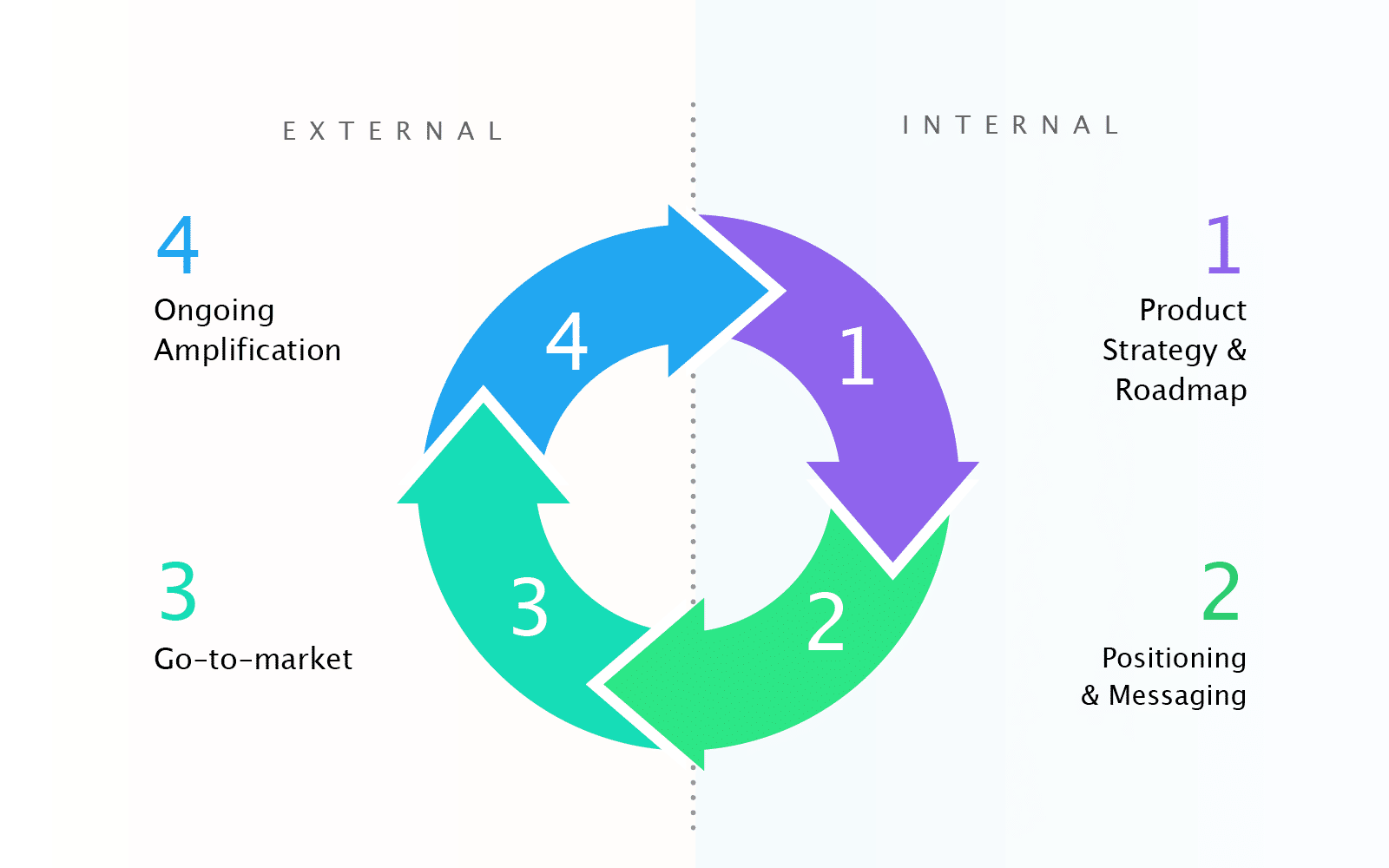A target market is a group of consumers within a company’s serviceable available market to whom marketing efforts and resources are directed. A target market, for example, is a subset of a product’s or service’s entire market. It is often made up of consumers that have similar qualities (such as age, geography, income, or lifestyle) and are thought to be the most likely to purchase a company’s market offers or to be the most profitable segments for the company to serve.
Once the target market(s) has been defined, the company would generally adjust the marketing mix (4 Ps) to the market’s wants and expectations. This may entail conducting extra customer research to get an in-depth understanding of the typical consumer’s motives, purchasing behaviors, and media usage patterns.
Choosing the “right” target market is a tough and time-consuming decision. However, a variety of heuristics have been created to aid in this decision-making process.
Plus, this guide will walk you through everything from target market segmentation to examples, tips, analysis, and demographics.
Overview
Target marketing entails segmenting a market and then focusing your marketing efforts on one or a few key groups comprised of clients whose needs and desires are most closely aligned with your product or service offerings. It has the potential to be the key to attracting new customers, growing revenue, and making your company a success.
The beauty of target marketing is that directing your marketing efforts toward certain groups of consumers simplifies and reduces the cost of promoting, pricing, and distributing your products and/or services, as well as providing a focus for all of your marketing activities.
Assume a catering company provides catering services in the client’s house. Rather than advertising in a newspaper appendix that is sent to everyone, the caterer would first select the target market for its services. It might then target the intended market with a direct mail campaign, flyer distribution in a certain residential area, or a Facebook ad focused on people in a specific location, enhancing its marketing ROI and bringing in more customers.
Social media networks like Facebook, LinkedIn, Twitter, and Instagram offer sophisticated alternatives for businesses to target people based on market groups. For example, a bed-and-breakfast establishment could target married Facebook followers with an ad for a romantic weekend getaway package. LinkedIn, on the other hand, is more B2B oriented, allowing you to target businesses based on a range of parameters such as employee count, industry, geographic area, and so on.
Although there are numerous approaches to market segmentation depending on how you want to divide the pie, three of the most prevalent forms are demographic segmentation, geographic segmentation, and psychographic segmentation.
Is a Target Market Necesssary?
The target market strategy is a key tool for increasing efficiency. And it is pretty important for a couple of reasons. Here are some reasons why;
#1. Target Marketing Discovers Potential for Growth
A small group of customers can provide the company with a huge chance to increase sales. One target market example is that while only a small percentage of ice cream purchasers are lactose intolerant (unable to digest milk), this segment may create significant earnings for a manufacturer of milk-free ice cream substitutes. A product built just for this market can readily capture their business.
#2. Target Marketing Builds Interest
Another example of the significance of a target market is that consumers in a target market share a number of qualities that make them more likely than other consumers to be interested in the business’s offering. These factors can be demographic, such as gender, age, and income level; behavioral, such as heavy product usage; or lifestyle-related, such as care about being active. One possible target market for athletic shoes, for example, may be adults who are younger, healthier, and more interested in sports than their peers.
#3. Target Marketing Creates Brand Loyalty
Promotional resources can be focused on a certain market, while the advertising message is tailored to resonate with customers in that group. Furthermore, a target market for Firm A is unlikely to receive the same level of attention from Firms B and C. These elements, when combined, increase the likelihood of brand loyalty.
#4. Target Marketing Keeps Firms Competitive
By narrowly focusing on a specific market, a corporation can promote itself as an authority on the demands and needs of that group. It can respond swiftly to changes in their interests or attitudes, and it can keep a close check on competing companies’ attempts to entice those consumers away.
Overall, its strong presence in the target market will operate as a deterrent to competitors looking to enter the same market, and maintaining a competitive edge may be one of the most critical advantages of target marketing.
The Difference Between a Target Market and a Demographic
Although the phrases are closely connected, they are not synonymous.
Target markets are typically far broader in scope than demographics. This is because many firms’ products or services appeal to a diverse spectrum of people. Target markets can also be influenced by factors such as buying cycles, product shelf life, and other factors that aren’t necessarily driven by people who might be interested in purchasing what you’re selling. Furthermore, when establishing their models and marketing plans, marketers frequently examine the long-term profit potential of a target market, implying that they must focus on the big picture.
Demographics, on the other hand, are subsets of a target market with similar characteristics. Many television advertisers, for example, actively target the coveted (and famously fickle) 18-35 age bracket. People beyond the age of 35 do not always fall outside of the advertiser’s target market; they just belong to a different demographic.
In other words, consider target markets to be a group of demographics who may be interested in your product or service.
What Is the Goal of a Target Market?
A product’s intended market defines it, and vice versa.
Once a target market has been established, it can influence the design, packaging, price, promotion, and distribution of a product.
For instance, a male-targeted product will not be packed in pink plastic. A high-end cosmetic will not be sold in a pharmacy. A high-priced pair of shoes comes with a branded cloth drawstring bag and a shoebox. All of these elements are indicators to the target audience that they have identified the proper product.
How to Conduct a Market Analysis
Target market analysis, as the name implies, is the foundation for defining your target market. Here are the steps you can take to do your own.
#1, Analyze Your Product or Service
Examine what you’re selling to determine which customers would benefit from your product. The following questions will aid in the brainstorming process:
- “How does your product or service meet a need?”
- “Does it ease any difficulties or alleviate any pain points?”
- “Who is the most likely to profit from your product or service?”
After you’ve answered these questions, consider soliciting feedback from current consumers. Set up a focus group or inquire with your service department about the most common issues.
This type of analysis of your product or service will assist you better understanding your target market. In reality, you may discover that your current consumers aren’t the people you’re attempting to reach. If you detect a discrepancy during this process, you should better align your target market with your actual marketing goals so that you can realign.
#2. Check Out the Competition
Analyze your competition to see who they are aiming for. Examine their customer base to discover if there is a segment of the market that you might focus on that they are overlooking.
The most effective approach to accomplishing this is to undertake a competitive analysis. You’ll conduct research to determine who your competitors are, what they offer, and even their sales strategies.
Like we earlier pointed out, examining your competition can also assist you in identifying target market gaps that you can fill. Are there any target markets that they aren’t concentrating on?
This could encourage you to geographically expand into other markets or develop new items to target a different market.
#3. Choose Criteria to Segment bBy
Several variables can be used to segment a target market. Consumers can be classified based on demographic, regional, and behavioral characteristics.
This is the process of developing a buyer persona. Your target market will be divided into multiple target customers, also known as (you guessed it) buyer personas.
For example, your target market could be midsized businesses wanting to purchase marketing automation software. Your target audience could be divided into numerous groups, such as marketing department executives, sales leaders, founders, or CEOs.
Here are a few of the most prevalent methods for segmenting a target market:
- Age
- Gender
- Income
- Location
- Behavior
- Lifestyle
- Values
- Interests
#4. Conduct Research
It’s time to do further research as you start to narrow down your market. What marketing methods should you employ in order to reach out to your desired target market? Is your product or service’s target market huge enough? You can discover more about your target market by conducting market research.
Picking the right target market can reveal a lot about your company. Do you want to be a real velocity business or a steady flow of pipeline with corporations and consumers?
#5. Keep Track of And Analyze Your Progress
Target market study should never be static – you don’t do one, be satisfied with the results, and then stop. It’s a never-ending process. To more effectively appeal to your target market, you must regularly track your findings, assess what you observe, and iterate on your vision of it.
Example of a Target Market Analysis
Consider a company that offers low-cost, “function-over-form” athletic footwear that prioritizes comfort and arch support over stylish looks.
#1. Analyze the Product or Service
When doing a target market study, the company in question must first take a thorough, impartial look at its product to gain a firm grasp of its value and distinctive qualities.
For example, a corporation would most likely discover that their shoes are better suited for everyday usage rather than actual athletic competition, lack stylish appeal, and can aid with painful feet while standing.
This preliminary understanding can help shape the personalities that the organization will eventually target. It would have a better idea of how to build its value proposition. In this scenario, the company may discover that suburban men over 50 who do not exercise often are the most likely to purchase its shoes.
#2. Check Out The Competition
The corporation would then investigate its competitors’ products, how they were sold, and any noticeable gaps in its potential target markets. Following a competitive analysis, the company may discover that its competitors were disregarding specific geographical trends present in their target markets.
Assume that its competitors’ retail locations and shop placements were predominantly in cities while neglecting suburban strip malls and local “mom and pop” retail establishments. With that knowledge, the company in question may have a starting point for appealing to a target market that its competitors are neglecting.
#3. Choose a criteria to segment by
At this point, the organization would begin to connect increasingly complex identities. Once again, it would base its segmentation criteria on product analysis and improve them based on competitor analysis.
In this example, a large percentage of the criteria would focus around age, social class, location, and interests, resulting in one of its personas being elderly, working-class, suburban consumers who value function above form.
#4. Conduct Research
Following the creation of its target persona, the company would conduct a market analysis, survey consumers who fit the bill for its target market, potentially employ more direct tactics such as hosting focus groups, and take any other steps necessary to ensure that it has a thorough understanding of its target consumers and what makes them tick.
From there, it may develop a deliberate value proposition to drive its sales messaging, outreach techniques, price structure, and other critical sales-related variables that will define how it approaches consumers and capitalizes on their potential interest.
#5. Track and Evaluate Results
After completing the other parts of the study, the organization will continue to analyze how its efforts are connecting with its target persona. If sales aren’t where they should be — or it appears that the company has additional personalities it can cater to — the corporation may restart this process and shift gears on its messaging, strategy, or target market as a whole.
Let’s look at some of the best-in-class businesses — both B2C and B2B — to see how they set up their target markets.
Examples of Target Markets
The following target market examples would guide you in setting yours up in the right manner.
#1. Atlassian’s Target Market Example
Atlassian provides a set of collaborative tools to assist developers and product managers in taking their projects from idea to completion. A short glance at their “Customers” page reveals that it operates in a variety of industries.
Atlassian, like most larger firms, uses target market segmentation to examine various markets and break down its distinct value propositions, terminology, and values.
By focusing on a single industry, such as retail, you would see that they collaborate with a number of significant corporations, particularly on support-related products.
This demonstrates that, while Atlassian can collaborate with practically everyone involved in software development, it understands how its value proposition varies depending on the industry area in issue.
Even the same product created varying degrees of value for two different consumer categories.
#2. Nike’s Target Market Example
Nike sells products to athletes and other individuals who desire to exercise on a daily basis. They sell clothing, equipment, shoes, and accessories.
They work with athletes and a fitness-conscious market, but we all know that a decent target market description cannot be so broad. Let’s break down two of their segments:
Young athletes – Children who get regular exercise and participate in sports as they grow up are a large and increasing market for Nike. Nike participates with this market through sports leagues and associations, as well as endorsements from well-known athletes such as LeBron James.
Runners— Nike demonstrates how it targets consumers based on demographic information as well as lifestyle by focusing on new styles of sneakers. Nike introduces shoes and clothes designed to help avid runners stay on the road for a little longer.
#3. Starbucks’s Target Market Example
Consider the target market of the top coffee spot in town, Starbucks, the next time you’re enjoying your cool foam Cascara cold brew.
Many of their locations have been refurbished and now have a hip, modern vibe. It’s not unexpected given that over half of their clients are between the ages of 25 and 40.
Read Also: STARBUCKS LOGO: Evolution, Significance, Branding Models & Tips
If you sit for more than five minutes drinking your coffee, you’ll most likely hear the barista exclaim “mobile order.” The mobile procedure currently accounts for 24 percent of Starbucks’ transactions, indicating that the company caters to a tech-savvy audience.
The placement of their shops is the next information we have about their target market. Starbucks attracts on-the-go professionals by strategically placing their outlets in densely populated regions. To summarize, Starbucks’ target markets are as follows:
- 25-40 year olds — Remodeled locales cater to their most populous demographic.
- Adults who are tech-savvy — Their mobile app has grabbed on and appeals to a forward-thinking audience.
- Professionals at work — Their urban orientation indicates the type of lifestyle they cater to.
#4. Apple’s Target Market Example
What about a business that operates in both the B2B and B2C markets? With such a diverse consumer base, how can it build a target market? Apple is the textbook example of product design and innovation.
But how does this relate to locating a target market? Apple provides something for everyone with their diverse product choices. Two of their target markets are as follows:
Technology Enthusiasts – Despite being a client segment that Apple first targeted decades ago, technology enthusiasts continue to receive attention from the company. With the introduction of new product categories (such as wearables, Apple TVs, and HomePods), Apple has demonstrated that it is still adding value to this market. There is also a huge ecosystem play where purchasing a suite of Apple products allows for improved interoperability across your technology.
Healthcare—This is another market in which Apple is interested in. They’ve positioned healthcare providers to engage with patients more conveniently by emphasizing the attractiveness of having information at your fingertips with mobile and the iPad.
Apple does not appear to exclude many people from its target market and has positioned itself to assist both consumers and businesses — even with devices such as the iPad.
Its success has been based more on appreciating the worth of its many parts than on excluding people from them.
#5. McDonald’s Target Market Example
McDonald’s target market is diverse and includes a wide range of customer personalities. Younger professionals are a significant target market demographic for the business, and this trend is reflected in many of the company’s facility remodels. Several McDonald’s locations have been redesigned to be sleeker, more modern, and more appealing to millennials.
Another important base for the chain is “full nest” families with children over the age of six. The franchise’s efforts to appeal to this specific niche are most seen in the Happy Meal alternatives it provides.
But there is one aspect that underpins almost every target demographic McDonald’s attempts to reach: social class. The chain also makes a concerted attempt to appeal to lower, working, and middle-class customers.
Meanwhile, McDonald’s value proposition is based on pricing. It aims to position itself as a low-cost alternative to more expensive solutions in the markets where it hopes to sell. When promoting its McCafe line, for example, the company highlighted the brand’s particularly low price points as a primary selling factor.
Finally, the franchise’s target market isn’t distinct and clear-cut in terms of most demographics — but it is specific in terms of the economic conditions of its many characters. Its value proposition is fundamentally based on the fact that its food is reasonably priced.
How to Define Your Target Market
The following are simple easy peasy steps to help you define your own target market stress-free.
#1. Take a Look at Your Current Customer Base
Who are your current clients, and why do they continue to do business with you? Look for shared traits and interests. Which ones provide the greatest revenue? Other people like them are quite likely to profit from your product/service as well.
Read Also: Upselling Explained With Practical Examples, Rules & Techniques
#2. Examine Your Competition
Who are your competitors aiming for? Who are their current clients? Don’t pursue the same market. You might discover a market niche that they are ignoring.
Read Also: Niche Marketing: Best Practices and all you need (+ Free Research Tips)
#3. Analyze Your Products and Services
Make a list of all the features of your product or service. List the benefits of each feature next to it (and the benefits of those benefits). A graphic designer, for example, provides high-quality design services. The advantage is a more professional company image. Customers will be drawn to a firm with a professional image because they perceive it to be professional and trustworthy. So, in the end, the reward of high-quality design is more customers and more money.
After you’ve listed your benefits, establish a list of persons who have a need that those benefits address. A graphic designer, for example, could opt to target organizations that want to expand their client base. While this is still too broad, you now have a starting point.
Read Also: MARKET RESEARCH: definition, Types, & Guide To Different Research Method
#4. Select a Specific Demographics to Target
Determine not only who has a need for your product or service, but also who is likely to purchase it. Consider the following factors:
- Age
- Location
- Gender
- Level of income
- Degree of education
- Relationship or family status
- Occupation
- Ethnic origins
#5. Consider Your Target’s Psychographics
Psychographics is a prospect’s more personal qualities, which include:
- Personality
- Attitudes
- Values
- Interests/hobbies
- Lifestyles
- Behavior
Determine how your product or service will fit into the lifestyle of your target audience. When and how will your target audience use the product? What characteristics are most appealing to your target audience? What types of media do your target audience use to receive information? Does your target read the newspaper, go online, or go to certain events?
Read Also: PSYCHOGRAPHICS: Best Practices & All You Need To Know, Simplified!
#6. Analyze Your Options
Once you’ve settled on a target market, evaluate the following questions:
- Is there a sufficient number of people who meet my requirements?
- Will my intended audience benefit from my product/service? Will they realize the value in it?
- Do I know what motivates my target to make decisions?
- Are they able to afford my product/service?
- Is it possible for me to reach them with my message? Are they easy to find?
Don’t go too far in breaking down your goal! Keep in mind that you can have more than one niche market. Consider whether your marketing message should be tailored to each specialty. If you can effectively reach both niches with the same message, you may have segmented your market too much. Also, if you discover that only 50 people meet all of your criteria, you may want to reconsider your goal. The trick is to strike the right balance.
“How do I find all this information?” you may wonder. Try looking online for other people’s research on your target. Look for magazine articles and blogs about or about your target demographic. Look for blogs and forums where people in your target market express their thoughts. Also, look for survey findings or try doing your own survey. Request feedback from your present consumers.
Generally, the difficult step is always defining your target market. Once you know who you’re trying to reach, it’s a lot easier to figure out what media to engage and what marketing messages will resonate with them. Rather than sending direct mail to everyone in your ZIP code, you can limit it to those who meet your criteria. By defining your target group, you can save money and obtain a greater return on investment.
Target Market FAQs
What is a target market example?
A target market is a consumer group that is most likely to want or require a company’s products or services. This group of people is a subset of the whole market for the company. For example, a children’s toy may have a target market of boys ages 9–11 and a target audience of the boys’ parents.
How do you define a target market?
The following are steps to define a target market;
- Take a Look at Your Current Customer Base
- Analyze Your Products and Services
- Examine Your Competition
- Select a Specific Demographics to Target
- Consider Your Target’s Psychographics
- Analyze Your Options
What are the 4 target markets?
The four types of segmentation that can assist determine your company’s primary target audience are geographical, demographic, psychographic, and behavioral.





